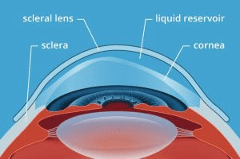Over the last several years, there has been an increased focus on keratoconjunctivitis sicca, also known as dry eye syndrome (DES). DES is a multifactorial disease with multiple causes and triggers. Patient symptoms vary but may include blurred vision, discomfort and foreign body sensation. DES results in tear film instability and in more extreme cases can result in permanent damage to the ocular surface. As our understanding of DES continues to develop, so has available treatment options
Traditional treatments include lubricants, punctal plugs and prescription medications. In the past rigid lenses were used as an off-label treatment for dry eye. Recently Scleral Lenses have received United States Food and Drug Administration (FDA) approval for the therapeutic management of ocular surface disease from dry eye.
What are scleral lenses?
Scleral lenses are large diameter rigid gas permeable (RGP) lenses that cover the entire cornea and rest on the sclera (white part of the eye). They are designed to completely vault the cornea and create a fluid reservoir that baths the cornea during the entire duration of wear. The fluid reservoir is created by use of sterile saline solution that is placed into the bowl of the lens prior to insertion. The optical nature of the lens corrects for any surface abnormalities and helps patients achieve clear and comfortable vision which typical spectacles and soft contact lenses can not provide.
Benefits of Scleral Lenses
- Do not irritate the cornea
- Ensures constant corneal hydration
- Protects the cornea from the environment
- Can be used in conjunction with other ocular treatments and medications
- Excellent visual quality

Ask your doctor if scleral lenses are a good treatment option for you.

